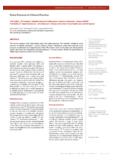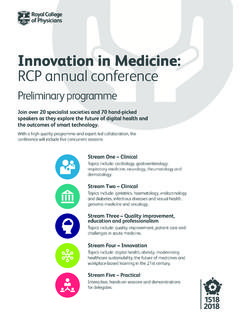Transcription of Heart Failure with a Preserved Ejection Fraction: …
1 INTRODUCTIONMore than thirty years ago, it was recognised that signs and symptoms of Heart Failure may occur in patients in whom the Ejection fraction of the left ventricle (LV) is within normal limits. Although origi-nally studied in patients with genuine hypertrophic cardiomyopathy, Heart Failure with Preserved LV Ejection fraction (HFPEF) has now been recognised in a more common population, which is character-ised by a high prevalence of female gender, arterial hypertension, advanced age, obesity and diabetes mellitus. Interestingly, community surveys on chronic Heart Failure in general have shown that the overall dis-tribution of left ventricular Ejection fraction (LVEF) among patients with Heart Failure is bell-shaped1 and that the fraction of patients with a Preserved LVEF within this distribution is much larger than anticipated, currently being about 50% of patients2.
2 Strikingly, in contrast to patients with a reduced LVEF (HFREF), no improvements in outcomes have been documented over the past twenty years. In this paper, we will review pathophysiological insights underlying both symptoms and disease progression in HFPEF and contemplate in which di-rection research should develop in the next decade. CORRESPONDENCEG illes De Keulenaer, MD, PhDCenter for Heart Failure and Cardiac RehabilitationAZ Middelheim University of AntwerpLindendreef 1, 2020 Antwerp, BelgiumTel: +32 3 265 23 38 Fax: +32 3 265 24 12E-mail: 2042-4884 ABSTRACTD iagnosing and managing Heart Failure according to the left ventricle s Ejection fraction (LVEF) has become part of evidence-based medicine. Not surprisingly, LVEF - a powerful prognostic factor in Heart Failure - has caused a marked heterogeneity in the clinical benefit of various therapeutic interventions.
3 From a pathophysiological point of view, however, many disease characteristics are shared among the entire Heart Failure spectrum (from low to high LVEF). The many functional and anatomical differences within the spectrum are merely quantitative, with an extensive overlap between the extremes of the spectrum and belonging to the same linear relation when plotted against LVEF. Therefore, although counter-intuitive from a clinical point of view, from a patho- physiological point of view Heart Failure seems to progress along a common disease trajectory independently of LVEF. In this review, we will scrutinise this apparent paradox, estimate how it relates to the recent biomarker-oriented (as opposed to a classic LVEF-oriented) approach to Heart Failure and discuss to what extent it may affect conceptual progress in chronic Heart Failure .
4 Heart Failure with a Preserved Ejection Fraction: From Pathophysiology to Biomarkers .. and Beyond! Heart Failure | REVIEWG illes De Keulenaer, MD, PhDCenter for Heart Failure and Cardiac Rehabilitation, AZ Middelheim University of AntwerpReceived 14/2/2011, Reviewed 19/2/2011, Accepted 21/2/2011 DOI: 90 EUROPEAN JOURNAL OF CARDIOVASCULAR MEDICINE VOL I ISSUE IIIP athophysiologyThe pathophysiology of HFPEF consists of two parts. First, it explains clinical symptoms of HF-PEF. Second, it clarifies its irreversible patho-physiological progression. Although these pathophysiological aspects may be related, les-sons from the past should remind us that a ther-apeutic intervention that reduces symptoms in Heart Failure do not per se halts the progression of the disease, and vice versa. Pathophysiology of HFPEF symptomsSymptoms of HFPEF are characterised by exer-cise intolerance and breathlessness on exertion.
5 These chronic symptoms may be alternated by acute episodes of lung edema or global volume overload, usually precipitated by severe hyper-tension, non-compliance to therapy, (pulmo-nary) infection, inappropriate tachycardia (usu-ally atrial fibrillation), or a combination of two or more of these many patients with suspected HFPEF an alter-native non-cardiac explanation for symptoms can be identified (like obesity, muscular decon-ditioning, pulmonary disease or angina), which may lead to misdiagnosis4. This is a relevant problem in clinical cardiology, which compli-cates the design of clinical trials in HFPEF and urges defining guidelines for is it not surprising that we fail to recognise two clear-cut distinct types of structural and functional LV remodelling? LV re-modelling is the product of multiple interacting and complex sig-nalling processes.
6 The contribution of each of these processes is linked to the patient s biological profile and medical background. For example, some of these processes are triggered by myocardial ischemia, myocardial infection or type I diabetes; these processes seem to promote predominant eccentric remodeling. Other signal-ing processes are influenced by type II diabetes, obesity, arterial hypertension and female gender; these tend to promote concen-tric remodelling. The biochemistry of these signalling processes are under intense investigation and has been related to intermediate mediators such as leptin, oxidative stress, hyperinsulinemia, estro-gen, cytokines, etc. In vivo, these mediators and their complex sig-nalling events merge in qualitative and quantitative combinations, specific for each patient. In a population of patients with Heart fail-ure, this creates heterogeneity, leading to a continuous spectrum of overlapping phenotypes15.
7 Any attempt to dichotomising this spectrum is artificial and lacks a conceptual to the above reasoning, HFPEF and HFREF progress along the same pathophysiological trajectory, and only vary in the quantitative contribution of numerous signaling events. So why then, one may argue, have clinical trials on the inhibition of the re-nine-angiotensin system, been successful in HFREF and disappoint-ing in HFPEF? Does this not contradict the premise that HFPEF and HFREF are part of a common disease trajectory? No, it doesn t. Imposing an arbitrary cut-off in any of the many prognostic continuous variables of Heart Failure , be it LVEF or any of the other currently available biomarkers, does not necessarily sig-nify that a novel paradigm is generated or that disease taxonomy should be introduced, even if it unveils a different clinical response to a therapeutic intervention.
8 91 EUROPEAN JOURNAL OF CARDIOVASCULAR MEDICINE VOL I ISSUE IIIN evertheless, it is now well established that patients with HFPEF also suffer from severe cardiovascular abnormalities that exacer-bate exercise intolerance, which firmly increase patient s risk for episodes of acute Heart Failure . These abnormalities predominantly manifest during active LV relaxation and diastolic filling, leading to so-called diastolic dysfunction . The entire pathophysiological picture of HFPEF as a syndrome is, however, more complex than an isolated problem of LV diastolic function. Abnormalities of LV relaxation and filling consist of impaired active LV recoil and suc-tion, blunted LV lusitropic response to adrenergic stimulation and a steep diastolic LV pressure-volume relation5. When occurring in combination and often exacerbated by deranged ventriculo-vascu-lar coupling, these abnormalities explain the low LV preload reserve and the low pulmonary capillary wedge pressure (PCWP)/work ra-tio of HFPEF patients.
9 By increasing PCWP, they may also explain the high prevalence of pulmonary arterial hypertension in HFPEF, un-less other yet to be identified pathophysiological processes would lead to pre-capillary pulmonary hypertension6. Accordingly, the pathophysiology of clinical symptoms of patients with HFPEF is predominated by diastolic LV dysfunction. The sub-cellular processes leading to diastolic LV dysfunction are beyond scope of this review but include an abnormal inactivation of the excitation-contraction process, passive myocyte stiffness, extracel-lular matrix abnormalities and impaired paracrine endothelial sig-nalling. Pathophysiology of HFPEF progressionApart from the fact that HFPEF is associated with diastolic LV dys-function, it is also usually associated with a progressive concentric LV remodelling. Similarly, HFREF is associated with systolic dysfunc-tion, but also with progressive eccentric LV remodelling.
10 These as-sociations between function and morphology of the left ventricle, together with the LVEF-based design of clinical trials, have created a tendency to dichotomise Heart Failure in two separate patho-physiological entities, apparently progressing along two divergent pathophysiological trajectories (Figure 1). However, diastolic dysfunction is not unique for HFPEF; it even is the strongest determinant of symptoms in HFREF7. Also, systolic dysfunction is not unique for HFREF8. In addition, concentric and eccentric LV remodelling often occur in combination, independent-ly of LVEF. These observations suggest that HFPEF and HFREF are related, overlapping entities and may progress along a common pathophysiological trajectory (Figure 1). Consistently, there currently is not a single pathognomonic feature, at any level of biological complexity (gene, protein, cell, organ, or organ system) that distinguishes HFPEF from HFREF.








